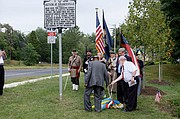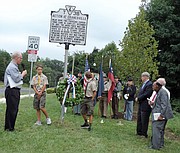A ceremony for the rededication of the Civil War marker at Georgetown Pike was held on Saturday, Sept. 24, at Dranesville Church of the Brethren to commemorate the 1861 Battle of Dranesville.
At the community’s request, the Virginia Department of Transportation has repositioned the marker next to Georgetown Pike (by the Seneca Hill Animal Hospital and Sunoco), in the center of where the historic battle took place many years ago.
The ceremony began inside the idyllic, picturesque church, which was built in 1912 by its congregation. After a moving invocation by the church’s Rev. Roland Smith, Bill Canis, local history enthusiast, opened with a warm welcome to all. “This event is unique in that it was not sponsored by just one group or individual,” he remarked. “It came about as a result of a spontaneous uprising of local residents who wanted to see our local history recognized and commemorated.”
Not many may be aware of the significance that this area had at that time in history. The town of Dranesville, which can now be described as anywhere between Sterling and Langley, was the largest town in Northern Virginia. It had five taverns, a hotel, churches, a schoolhouse, blacksmiths, and anything else that the people could have needed. Up to 60 wagons travelled up and down Leesburg Pike each day, transporting produce and fresh food to cities like Georgetown and Alexandria.
IN THE FALL OF 1861, Union forces known as the Pennsylvania Reserve Volunteer Corps, took position in Langley, while the Confederate troops were concentrated in Centreville. After a multitude of small ambushes and raids back and forth between the two sides, the Union troops, led by Gen. Thomas L. Kane, set out in the bitter cold morning of Dec. 20 to attack the Confederates. Under Brig. J.E.B. Stuart’s orders, the Southern forces were stationed in Dranesville, out foraging for supplies that very same day and were surprised by the strike. Among the Confederate soldiers, there were 43 killed and 143 injured, while the Union suffered a lesser 7 deaths and 61 wounded. The seemingly small engagement provided a boost to Northern morale, which had taken a hit during the summer and fall.
Speaker John Waggoner and local historian Karen Washburn described the scene of this battle in vivid detail, as well as how it affected the people of that time. “They were normal people, just like us,” Washburn said. “But there was no one to call to clean it all up, and they were suddenly faced with bullet holes in their barns and bodies on the grounds of their land.”
AS THE OPENING CEREMONY came to a close, a group of Civil War re-enactors, authentic musician, Jon Vrana, and Boy Scout Troops 673 and 55 led the way to the new marker off of Georgetown Pike. VDOT representative Mike Gleasman spoke about the process of moving the marker, as well as his own personal connection to this piece of history, as he had three ancestors who fought and died in the civil war.
“Our history is a very, very important thing to remember and appreciate,” said Supervisor John Foust (D-Dranesville). As William Faulkner so eloquently put it: “The past is never dead. It isn’t even past.”



